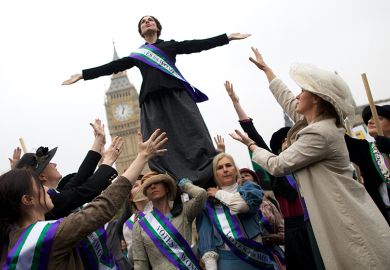Shanghai has long been imaged as China's most vibrant emblem of modernity. It has simultaneously enjoyed a reputation as a cosmopolitan centre of excitement and seduction and as a place of corruption, abuse of power and danger, dating from the infamous Green Gang of the Republican period to the Gang of Four of the Cultural Revolution. The threads of these themes come together in Gail Hershatter's aptly titled and important Dangerous Pleasures, a detailed, imaginative and lucidly written survey of prostitution in Shanghai from the late 19th to the late 20th century. The beautiful and cultured courtesan appears as a trophy of elite male success in understanding the art of brothel etiquette. The impoverished street walker is a metaphor for moral turpitude, social disorder and the dangers of disease. As a composite figure, the prostitute is a symbol of national weakness, as well as the target of the regulatory zeal of exponents of reform and revolution. Prostitution emerges as a theme through which intellectual concerns about gender, the nation and modernity were articulated.
Starting with an examination of the hierarchy of prostitution between the late 19th and Republican periods, Dangerous Pleasures argues that prostitution covers widely differing interests and practices. Even the assumption that different forms of prostitution share a core meaning in the sale and purchase of sex raises the question of the meaning of "sex". Sexual intercourse was a minor and by no means guaranteed component of the relations between courtesan and client. The various categories of prostitutes were associated with different socio-economic and political purposes. Their spatial organisation in the city, whether in the flop-houses of the Chinese city, or as "pheasants" working the streets of the International Settlement and the French Concession, or in the exquisitely appointed interiors of the courtesan house, itself indicated important divisions of interest and opportunity. A high-class courtesan could simultaneously be identified as cultured arbiter of taste and fashion, as judge of urbane masculinity whose power to ridicule and dispense favours was a matter of status as much as of entertainment, or as victim of an avaricious madam.
Hershatter presents prostitution as a range of competing discourses, in which the prostitute appeared more as a vehicle for particular concerns than as an agent of her own life. The emerging medical elite's attempts to assert their dominance over the traditional "quacks" were often channelled through their claims to expert knowledge about the dangers of prostitution in spreading sexual transmitted diseases. Legal and reform discourses constructed the figure of the victimised or dangerous prostitute as a symbol of the need for broad programmes of social regulation.
Evidence suggests that prostitutes of the Republican period were commonly enmeshed in familial ties and responsibilities, and yet one of the dominant themes in reform literature and police reports featured the prostitute as severed from her family and a threat to familial order. Foreshadowing a prominent approach of the 1950s, reformist debates of the 1920s and 1930s presented education of the prostitute as a means to stabilise the familial, social and moral order. Prostitution emerges not as a coherent narrative, but as a combination of shifting meanings in which the prostitute becomes a vehicle for debates about the needs, possibilities and pitfalls of modernity. Only under Communist rule in the 1950s did the theme of prostitution become a unified discourse when it was unequivocally identified as an evil to be eradicated in the name of national strength.
One of the interesting features of the reform period since the 1980s is that prostitution is not characterised as sex work. Prostitution in China has been associated with moral degeneration and social dislocation, with the effects of increased internal and external migration and sex discrimination in work, housing and education. It is also widely discussed in conjunction with the perils of drug use, sexually transmitted disease and HIV. Women's studies researchers regard prostitution as a sign of women's unequal status in the changed conditions of a market economy, but they do not tend to characterise it as work.
Through nearly 600 pages, this book's intricate and vivid descriptions offer a vision of how prostitutes figured in intellectual and political debates on Chinese modernity. As Hershatter warns from the start, it is not about the ways in which women saw their lives. In large part this is due to the range of historical materials that is available. The sources on which this book is based -Jtravel essays and brothel guidebooks, the mosquito press (gossipy tabloid newspapers), legal and police records and, for the more recent period, social surveys, reportage and popular literature, the official press and research papers - do not record women's voices. These kinds of materials do not reveal the mundane, day-to-day details about, for example, menstruation, ablution, contraception, childbirth and mothering. For the post-1949 period, the difficulties in identifying the voice of the prostitute are further complicated by the state's control of the language of public discourse of the oppressed. When the subaltern spoke in public, she used terms adopted from the state.
This book sensitively explores a particular kind of history, hitherto marginalised by the intellectual and cultural concerns of mainstream historical writing. Hershatter constantly reminds us that the historian's task to remember and explain the past is inevitably limited by the impossibility of fully retrieving the voices of its subjects. Despite the absence in this book of prostitutes' voices, the reader is offered many important clues about their material lives. As Hershatter argues, the subaltern's interventions in the materials available to the historian leave important traces enabling us to understand at least some of the ways in which her life departed from the themes of the discourses around her.
Harriet Evans is senior lecturer in Chinese, University of Westminster.
Dangerous Pleasures: Prostitution and Modernity in Twentieth-Century Shanghai
Author - Gail Hershatter
ISBN - 0 520 20438 7
Publisher - University of California Press
Price - £35.00
Pages - 591
Register to continue
Why register?
- Registration is free and only takes a moment
- Once registered, you can read 3 articles a month
- Sign up for our newsletter
Subscribe
Or subscribe for unlimited access to:
- Unlimited access to news, views, insights & reviews
- Digital editions
- Digital access to THE’s university and college rankings analysis
Already registered or a current subscriber?



